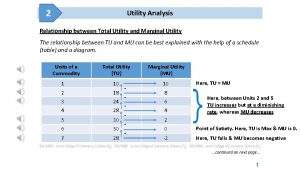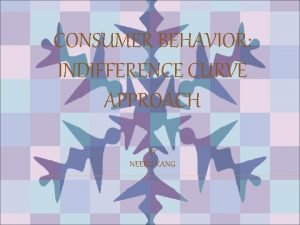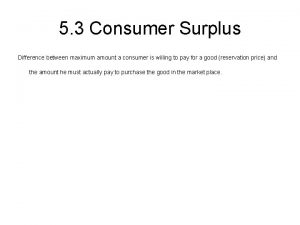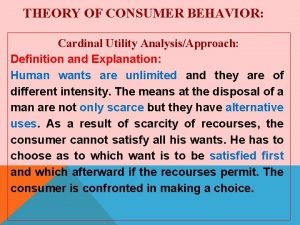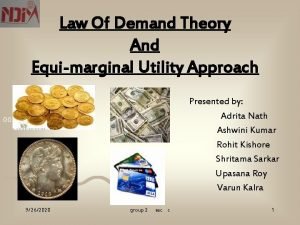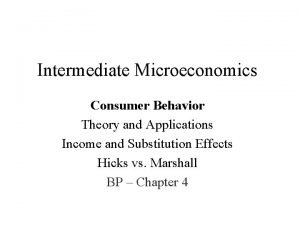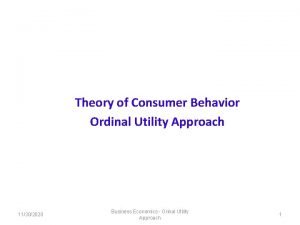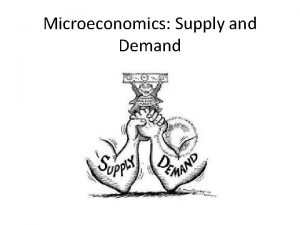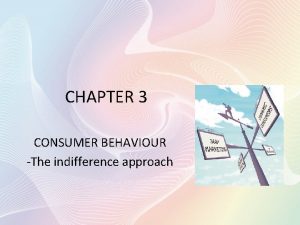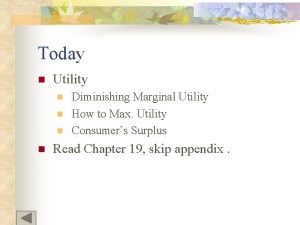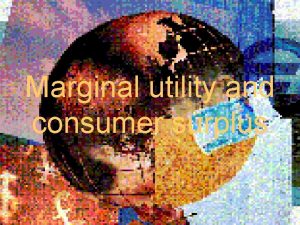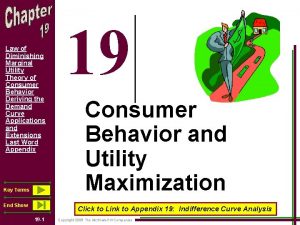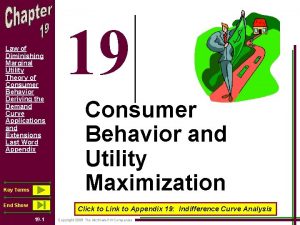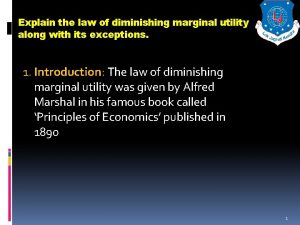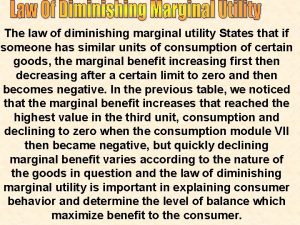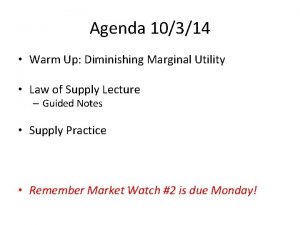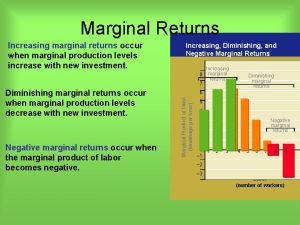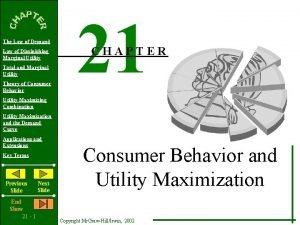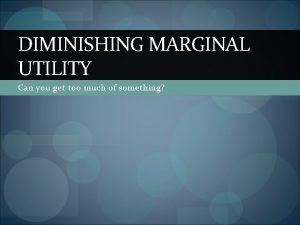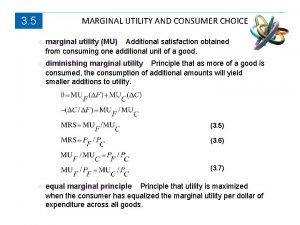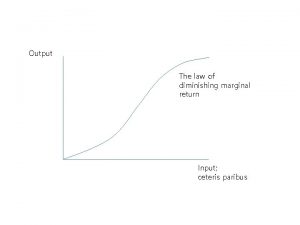Law of diminishing marginal utility IntroductionLaw of diminishing























- Slides: 23

Law of diminishing marginal utility Introduction-Law of diminishing marginal utility ü Wants or desires are one of the distinguishing features of all living creatures but are pronounced most staunchly by human beings. ü Our life is geared towards satisfaction of wants.

Characteristics of wants ü Wants have the following characteristics: i) wants are unlimited in number and variety ii) particular want is desirable iii) wants are complementary iv) wants are competitive v) wants are alternative vi) wants are recurrent and vii) wants may be unconscious also

Utility üWants are satisfied by consuming goods and services. The want satisfying power of goods and services is called utility.

There are four forms of utility: Form utility ü If the utility of a good changes when its physical form is changed, it is called form utility. ü The utility of wood, for example, increases when its physical form is changed into finished goods such as Tables and Chairs.

Place utility ü When the utility changes when a good is moved from one place to another, then it is called place utility. ü Transport of apples from Himachal Pradesh, for example, to South India fetches a higher price as its utility increases.

Time utility ü When the utility of a good changes due to time, it is known as time utility. ü Many food products are produced during seasons but if they are preserved and marked during off season period, their utility, reflected by price, increases

Possession Utility ü If the utility of a good changes when owned by a popular person then it is called possession utility. ü An example is the pen or spectacle used by Mahatma Gandhi.

Law of diminishing marginal utility ü We live in the pursuit of satisfying our wants. However, the process of satisfying wants is influenced by the law of diminishing marginal utility. ü When a person consumes a good successively, the utility derived from the consumption of each successive unit of the good goes on decreasing, becomes zero and then turns negative which forces consumption of the good to stop.

Alfred Marshall defined the law as follows: ü “The additional benefit which a person derives from a given increase of his stock of a thing diminishes with every increase in stock that he already has”.

The law operates for two reasons: i) Each want to satiable; and ii) Goods are imperfect substitutes for one another and they tend to be consumed in appropriate proportions.

The law could be explained using an example: Consumption of Tomato

The above Table shows how the marginal utility decreases with consumption of each successive unit of tomato. It could be shown in Figure 1 wherein the law is explicit.

Approaches to utility ü There are two approaches to the concept of utility. ü The classical economists believed utility could be measured and they defined it as cardinal utility.

ü On the other hand, the ordinal utility approach explained that utility cannot be measured and could only be ranked based on individual tastes and preferences. ü Hence, they defined utility as ordinal utility. It explains utility with Indifference Curve Technique.

Indifference schedule ü An indifference schedule may be defined as a schedule of various combinations of two commodities which yield the same level of satisfaction to the consumer.

Indifference Curve ü The indifference curve is defined as locus of the various combinations of two commodities which provide the same total satisfaction to the consumer. ü The curve is also referred to as the iso- utility curve or curve of equal utility (Figure 2).


Indifference Map ü An indifference map shows a collection of indifference curves each of which offer a certain total satisfaction to the consumer. ü The indifference curves are numbered in ascending order (Figure 3).


Properties of indifference curves ü The indifference curves show three important properties: i) they are downward sloping, ii) they are non-intersecting and iii) they are convex to the origin

Consumer’s Surplus ü The law of diminishing marginal utility helps to explain the concept of consumer’s surplus. ü The excess of utility foregone or disutility suffered is called consumer’s surplus. ü Hicks defined it as the difference between the marginal valuation of a unit of good and the price which actually paid for it.

ü It simple terms, consumer’s surplus refers to the difference between what we are prepared to pay and what we actually pay. ü The concept of consumer’s surplus is seen in the case of purchase of very useful commodities yet cheap. Some of the examples include soap, salt, post card, match box, new paper etc.

The consumer surplus is graphically presented in Figure 4.
 Demand basis
Demand basis Diminishing marginal utility
Diminishing marginal utility Relation between marginal utility and total utility
Relation between marginal utility and total utility Marginal productivity formula
Marginal productivity formula Law of diminishing mrs
Law of diminishing mrs Economic region of production diagram
Economic region of production diagram Cardinal utility approach
Cardinal utility approach Law of equi marginal utility
Law of equi marginal utility Law of equi marginal utility
Law of equi marginal utility Marginal rate of technical substitution
Marginal rate of technical substitution Demand curve for giffen goods
Demand curve for giffen goods Consumer equilibrium under cardinal utility approach
Consumer equilibrium under cardinal utility approach Rotation of budget line
Rotation of budget line Equalizing marginal utility per dollar
Equalizing marginal utility per dollar Rumus marginal utility
Rumus marginal utility Learning curve ekonomi manajerial
Learning curve ekonomi manajerial Law of diminishing returns
Law of diminishing returns Rate of diminishing returns
Rate of diminishing returns Newton's first law and second law and third law
Newton's first law and second law and third law Newton's first law
Newton's first law V=k/p
V=k/p Avogadro's law constant
Avogadro's law constant Law of equalising the weighted marginal utilities
Law of equalising the weighted marginal utilities Diminishing musharakah example
Diminishing musharakah example


